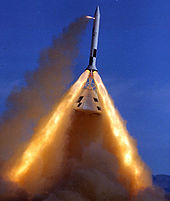Apollo rescue missile


The Apollo rescue rocket ( English Apollo Launch Escape System , LES ) was a rescue system for the astronauts of the Apollo program . In the event that an emergency situation occurred during take-off, the system was supposed to move the Apollo capsule from the tip of the Saturn rocket out of the danger area. The capsule would then have landed on its parachute like after a normal reentry. This case never occurred, so the LES was not activated on any of the Apollo launches.
The rescue rocket (also known as the rescue tower or Launch Escape Tower (LET) ) was mounted above the Apollo command module (CM) and formed the top of the launch configuration. The Saturn V was 10.05 meters high, 66 centimeters in diameter and weighed 4.17 tons. Three solid rockets with different tasks were integrated:
- The largest provided the drive and developed a thrust of 689 kN for 3.2 seconds .
- The second provided the right location; controlled by a control system called Q-Ball.
- The last one was responsible for the separation of CM and LES after the successful escape, but was also needed for a normal take-off to remove the tower from the spaceship Apollo at a height of 90 km .
In order to protect the command module from the propulsion gases of the rescue system as well as from the frictional heat of a normal take-off, there was another protective cover over the command capsule, the Boost Protective Cover (BPC) .
The system could activate itself or be triggered manually. Had the LES been used, it would have exposed the astronauts to an acceleration of over 15 g , twice as much as when returning from the moon.